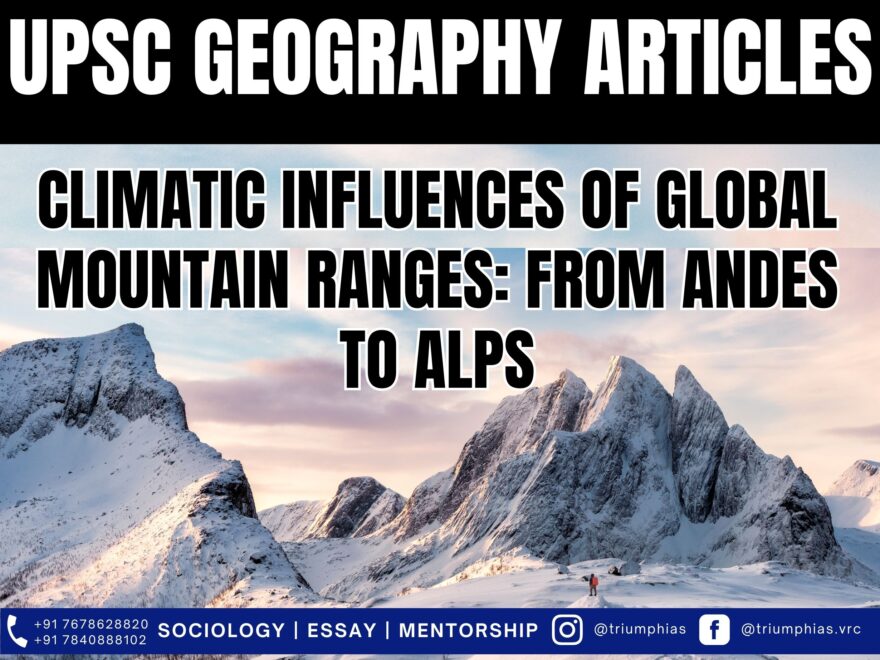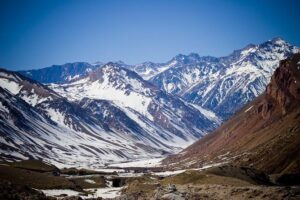Mountain Range: Its Climate Effect
(Relevant for Geography Section of General Studies Paper Prelims/Mains)
Mountain Range: Its Climatic Effect
A mountain range encompasses a sequence of ridges that formed during the same geological era and experienced similar geological forces. The defining attribute of mountain ranges is their lengthy and slender expanse.
Mountain Ranges and its Climatic Influence
- Andes Mountain Range (7,000 km): This range extends from north to south across seven South American countries along the continent’s western coast: Venezuela, Colombia, Ecuador, Peru, Bolivia, Chile, and Argentina. Because the Andes create a formidable barrier between the Pacific Ocean and the continent, they exert a significant influence on the region’s climate. The northern part of the Andes experiences regular rainfall and warmth, while the eastern portion of the central Andes and the southwest encounter wet weather. To the west, the arid climate prevails, dominated by the Atacama Desert in northern Chile. These mountains act as a rain shield over the eastern plains of Argentina, which typically suffer from extremely dry conditions.
- Himalayas (2,400 km): These Asian mountains separate the Indian subcontinent’s plains from the Tibetan Plateau. The range boasts some of the planet’s highest peaks, including Mount Everest, the highest of them all. The Himalayas profoundly influence the Indian subcontinent’s and Tibetan Plateau’s climates. They prevent cold, dry winds from sweeping south into the subcontinent, maintaining much warmer temperatures in South Asia compared to similar temperate regions on other continents.
- Rockies Mountain Range (4,830 km): These massive mountain ranges span from Canada to central New Mexico. The Rockies cast a considerable rain shadow, creating a dry area on the mountain range’s leeward side, where winds do not reach. This rain shadow results from the mountains blocking rain-producing weather systems and essentially casting a “shadow” of dryness. In essence, the rain shadow forces a desert into existence due to the mountain range it borders, preventing the eastern slopes and foothills from receiving the same moisture as the western side of the range.
- Great Dividing Range (3,500 km): Running roughly parallel to Australia’s east coast, the Great Dividing Range constitutes the fifth-longest land-based mountain chain globally and the longest entirely within one country. These mountains obstruct the flow of moist air from the Tasman Sea, causing rainfall over the range and reducing rainfall amounts in the inland regions to the west.
- Atlas Mountains (2,500 km): Stretching approximately 2,500 kilometers across north western Africa, the Atlas Mountains span Morocco, Algeria, and Tunisia. They separate the Mediterranean and Atlantic coastlines from the Sahara Desert. Westerly winds from the Atlantic Ocean transport moisture into the region, but the mountains serve as a climatic barrier between the coastal grasslands, wetlands, and the Sahara Desert. The Atlas Range leads to a rain shadow effect, limiting rainfall in areas beyond the mountains. During winter, the highest peaks of the Atlas Mountains are among the few places in Africa that witness snow.
- Ural Mountains (2,500 km): Extending from the Kara Sea to the Kazakh Steppe along Kazakhstan’s border, the Ural Mountains mark the northern part of the boundary between Europe and Asia. The northern side of the range experiences cool, rainy weather, while the southern side is characterized by a hot desert climate. The western side receives warm continental winds, while the eastern side is notably cooler and drier.
- Alps Ranges (1,200 km): The Alps are Europe’s highest and most extensive mountain range system, curving across eight Alpine countries: France, Switzerland, Monaco, Italy, Liechtenstein, Austria, Germany, and Slovenia.
The mountain ranges of the world provide essential ecosystem based services to global communities as well as inspiration and enjoyment to millions. These are particularly important for their biodiversity, water, clean air, research, cultural diversity, leisure, landscape and spiritual values.
Sample Question for UPSC Sociology Optional Paper:
1. Question: How do mountain ranges influence regional climates?
Answer:
Mountain ranges act as natural barriers that influence regional climates by affecting wind and moisture patterns, creating phenomena like rain shadows and climatic divisions.
2. Question: What is the rain shadow effect and which mountain range is a prominent example of it?
Answer:
The rain shadow effect occurs when a mountain range blocks moisture-bearing winds, leading to dry conditions on the leeward side of the mountains. The Rockies are a prominent example.
3. Question: How do the Himalayas affect the climate of the Indian subcontinent?
Answer:
The Himalayas act as a climatic shield that prevents cold, dry winds from entering the Indian subcontinent, thereby maintaining warmer temperatures in the region compared to similar latitudes on other continents.
4. Question: What role do the Andes play in the climate of South America?
Answer:
The Andes Mountain Range serves as a formidable barrier affecting regional climates, including causing regular rainfall in the northern part and creating a rain shield over the eastern plains of Argentina.
5. Question: How do the Atlas Mountains influence the climate of northwestern Africa?
Answer:
The Atlas Mountains act as a climatic barrier between the Mediterranean and Atlantic coastlines and the Sahara Desert, creating a rain shadow effect that limits rainfall in regions beyond the mountains.
Related Blogs …
 |
 |
To master these intricacies and fare well in the Sociology Optional Syllabus, aspiring sociologists might benefit from guidance by the Best Sociology Optional Teacher and participation in the Best Sociology Optional Coaching. These avenues provide comprehensive assistance, ensuring a solid understanding of sociology’s diverse methodologies and techniques.
Mountain Ranges, Climate Influence, Andes Mountain Range, Rockies Mountain Range, Great Dividing Range, Andes, Himalayas, Rockies, Great Dividing Range, Atlas Mountains, Ural Mountains, Alps, Rain Shadow, Weather Patterns, Ecosystem

Choose The Best Sociology Optional Teacher for IAS Preparation?
At the beginning of the journey for Civil Services Examination preparation, many students face a pivotal decision – selecting their optional subject. Questions such as “which optional subject is the best?” and “which optional subject is the most scoring?” frequently come to mind. Choosing the right optional subject, like choosing the best sociology optional teacher, is a subjective yet vital step that requires a thoughtful decision based on facts. A misstep in this crucial decision can indeed prove disastrous.
Ever since the exam pattern was revamped in 2013, the UPSC has eliminated the need for a second optional subject. Now, candidates have to choose only one optional subject for the UPSC Mains, which has two papers of 250 marks each. One of the compelling choices for many has been the sociology optional. However, it’s strongly advised to decide on your optional subject for mains well ahead of time to get sufficient time to complete the syllabus. After all, most students score similarly in General Studies Papers; it’s the score in the optional subject & essay that contributes significantly to the final selection.
“A sound strategy does not rely solely on the popular
Opinion of toppers or famous YouTubers cum teachers.”
It requires understanding one’s ability, interest, and the relevance of the subject, not just for the exam but also for life in general. Hence, when selecting the best sociology teacher, one must consider the usefulness of sociology optional coaching in General Studies, Essay, and Personality Test.
The choice of the optional subject should be based on objective criteria, such as the nature, scope, and size of the syllabus, uniformity and stability in the question pattern, relevance of the syllabic content in daily life in society, and the availability of study material and guidance. For example, choosing the best sociology optional coaching can ensure access to top-quality study materials and experienced teachers. Always remember, the approach of the UPSC optional subject differs from your academic studies of subjects. Therefore, before settling for sociology optional, you need to analyze the syllabus, previous years’ pattern, subject requirements (be it ideal, visionary, numerical, conceptual theoretical), and your comfort level with the subject.
This decision marks a critical point in your UPSC – CSE journey, potentially determining your success in a career in IAS/Civil Services. Therefore, it’s crucial to choose wisely, whether it’s the optional subject or the best sociology optional teacher. Always base your decision on accurate facts, and never let your emotional biases guide your choices. After all, the search for the best sociology optional coaching is about finding the perfect fit for your unique academic needs and aspirations.
To master these intricacies and fare well in the Sociology Optional Syllabus, aspiring sociologists might benefit from guidance by the Best Sociology Optional Teacher and participation in the Best Sociology Optional Coaching. These avenues provide comprehensive assistance, ensuring a solid understanding of sociology’s diverse methodologies and techniques. Sociology, Social theory, Best Sociology Optional Teacher, Best Sociology Optional Coaching, Sociology Optional Syllabus.
Best Sociology Optional Teacher, Sociology Syllabus, Sociology Optional, Sociology Optional Coaching, Best Sociology Optional Coaching, Best Sociology Teacher, Sociology Course, Sociology Teacher, Sociology Foundation, Sociology Foundation Course, Sociology Optional UPSC, Sociology for IAS,
Follow us :


https://t.me/VikashRanjanSociology
Find More Blogs
|
Scope of the subject and comparison with other social sciences |
|||
|
|
|
|
Modernity and social changes in Europe |


